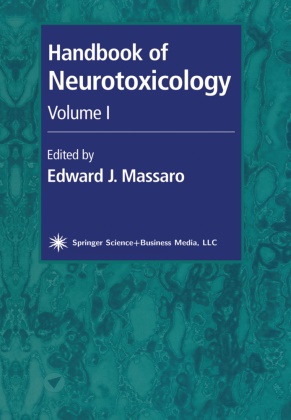Condividi
Fr. 261.00
Edwar J Massaro, Edward J Massaro, Edward J. Massaro
Handbook of Neurotoxicology. Vol.I
Inglese · Tascabile
Spedizione di solito entro 6 a 7 settimane
Descrizione
Neurotoxicology is a broad and burgeoning field of research. Its growth in recent years can be related, in part, to increased interest in and concern with the fact that a growing number of anthropogenic agents with neurotoxic potential, including pesticides, lead, mercury, and the polytypic bypro ducts of combustion and industrial production, continue to be spewed into and accumulate in the environment. In addition, there is great interest in natural products, including toxins, as sources of therapeutic agents. Indeed, it is well known that many natural toxins of broadly differing structure, produced or accumulated for predatory or defensive purposes, and toxic agents, accumulated incidentally by numerous species, function to perturb nervous tissue. Components of some of these toxins have been shown to be useful therapeutic agents and/or research reagents. Unfor tunately, the environmental accumulation of some neurotoxic ants of anthropogenic ori gin, especially pesticides and metals, has resulted in incidents of human poisoning, some of epidemic proportion, and high levels of morbidity and mortality. Furthermore, an increasing incidence of neurobehavioral disorders, some with baffling symptoms, is confronting clinicians. It is not clear whether this is merely the result of increased vigi lance and/or improved diagnostics or a consequence of improved health care. In any case, the role of exposure to environmental and occupational neurotoxic ants in the etiology of these phenomena, as well as neurodegenerative diseases, is coming under increasing scrutiny and investigation.
Sommario
I. Pesticides.- A. Anticholinesterase Insecticides.- 1 Acute Toxicities of Organophosphates and Carbamates.- 2 Organophosphate-Induced Delayed Neuropathy.- 3 Nonesterase Actions of Anticholinesterase Insecticides.- B. Pesticides that Target Ion Channels.- 4 Agents Affecting Sodium Channels.- 5 Agents Affecting Chloride Channels.- 6 The Neonicotinoid Insecticides.- C. Miscellaneous Pesticides with Action on the Nervous System.- 7 Miscellaneous Pesticides with Action on the Nervous System.- II. Metals.- 8 Molecular Mechanisms of Low-Level Pb2+ Neurotoxicity.- 9 Elucidation of the Zinc-Finger Motif as a Target for Heavy-Metal Perturbations.- 10 Blood-Brain Barrier and Blood-CSF Barrier in Metal-Induced Neurotoxicities.- 11 Manganese in Health and Disease: From Transport to Neurotoxicity.- 12 Aluminum Neurotoxicity.- III. Natural Toxins of Microbial Origin.- 13 Ecology of Microbial Neurotoxins.- 14 Biosynthesis of Important Marine Toxins of Microorganism Origins.- 15 Biological Assay and Detection Methods for Marine "Shellfish" Toxins.- 16 An Overview of Clostridial Neurotoxins.- 17 Molecular Mechanism of Action of Botulinal Neurotoxins and the Synaptic Remodeling They Induce In Vivo at the Skeletal Neuromuscular Junction.- 18 Marine Mammals as Sentinels of Environmental Biotoxins.- 19 The Epidemiology of Human Illnesses Associated with Harmful Algal Blooms.- IV. Natural Toxins of Animal Origin.- 20 Snake Neurotoxins that Interact with Nicotinic Acetylcholine Receptors.- 21 Presynaptic Phospholipase A2 Neurotoxins from Snake Venoms.- 22 Dendrotoxins from Mamba Snakes.- 23 Neurotoxins from Spider Venoms.- 24 Neurotoxins from Scorpion Venoms.- 25 Anthozoan Neurotoxins.- 26 Nemertine Neurotoxins.- 27 Secretagogue Activity of Trachynilysin, a Neurotoxic Protein Isolatedfrom Stonefish (Synanceia trachynis) Venom.- 28 Neurotoxins of Cone Snail Venoms.
Riassunto
Neurotoxicology is a broad and burgeoning field of research. Its growth in recent years can be related, in part, to increased interest in and concern with the fact that a growing number of anthropogenic agents with neurotoxic potential, including pesticides, lead, mercury, and the polytypic bypro ducts of combustion and industrial production, continue to be spewed into and accumulate in the environment. In addition, there is great interest in natural products, including toxins, as sources of therapeutic agents. Indeed, it is well known that many natural toxins of broadly differing structure, produced or accumulated for predatory or defensive purposes, and toxic agents, accumulated incidentally by numerous species, function to perturb nervous tissue. Components of some of these toxins have been shown to be useful therapeutic agents and/or research reagents. Unfor tunately, the environmental accumulation of some neurotoxic ants of anthropogenic ori gin, especially pesticides and metals, has resulted in incidents of human poisoning, some of epidemic proportion, and high levels of morbidity and mortality. Furthermore, an increasing incidence of neurobehavioral disorders, some with baffling symptoms, is confronting clinicians. It is not clear whether this is merely the result of increased vigi lance and/or improved diagnostics or a consequence of improved health care. In any case, the role of exposure to environmental and occupational neurotoxic ants in the etiology of these phenomena, as well as neurodegenerative diseases, is coming under increasing scrutiny and investigation.
Testo aggiuntivo
"Both volumes are laid out attractively...and contain much valuable information on the pharmacological aspects of neurotoxicology, as well as state-of-the-art methodology." Le Journal Canadien Des Sciences Neurologies
Relazione
"Both volumes are laid out attractively...and contain much valuable information on the pharmacological aspects of neurotoxicology, as well as state-of-the-art methodology." Le Journal Canadien Des Sciences Neurologies
Dettagli sul prodotto
| Con la collaborazione di | Edwar J Massaro (Editore), Edward J Massaro (Editore), Edward J. Massaro (Editore) |
| Editore | Springer, Berlin |
| Lingue | Inglese |
| Formato | Tascabile |
| Pubblicazione | 25.10.2010 |
| EAN | 9781617371936 |
| ISBN | 978-1-61737-193-6 |
| Pagine | 668 |
| Dimensioni | 179 mm x 37 mm x 257 mm |
| Peso | 1305 g |
| Illustrazioni | XV, 668 p. 93 illus., 7 illus. in color. |
| Categorie |
Scienze naturali, medicina, informatica, tecnica
> Medicina
> Farmacia
C, Mercury, Pharmacology, ZINC, Biomedical and Life Sciences, Pharmacology/Toxicology, pesticide, neurotoxicity, neurobehavioral assessment, neurotoxicology |
Recensioni dei clienti
Per questo articolo non c'è ancora nessuna recensione. Scrivi la prima recensione e aiuta gli altri utenti a scegliere.
Scrivi una recensione
Top o flop? Scrivi la tua recensione.

